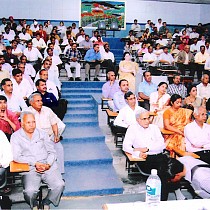BIOLOGY OF HELICOVERPA ARMIGERA (HUBNER) ON CHICKPEA UNDER LABORATORY CONDITION AT AMBIENT TEMPERATURE
 Department of Entomology, College of Agriculture, Bikaner Rajasthan Agriculture University Bikaner -334006 (India)
G.L. KULHARI, VEER SINGH AND H.L. DESHWAL
The biology of H. armigera was studied at ambient temperature under laboratory conditions. The eggs of H. armigera were spherical in shape with a flattened base which looked like dome shaped. The colour of eggs in the beginning was yellow – white, which became dark brown before hatching. The egg was 0.45-0.48 mm X 0.42-0.45 mm in size. The fecundity per female was 453.50 and 357.80 eggs in two the generations respectively. The per cent viability of eggs varied from 77 to 92 per cent during different periods of study. The longevity of male and female moths were 7.90-9.00 and 10.10-10.90 days respectively. The larvae passed through six instars with 32.70 and 40.20 days of total larval period in the both generation. The mean pre-pupal period in case of the Ist and IInd generation were 4.10 and 4.60 days, respectively. The average pupal period during the Ist and IInd generation were 22.20 and 24.00 days, respectively. H. armigera took 59.50 and 69.80 days in completing the Ist and IInd generation, respectively. The H. armigera completed two generations in Semi-Arid region of Rajasthan from November to March in semi arid region of Rajasthan.


